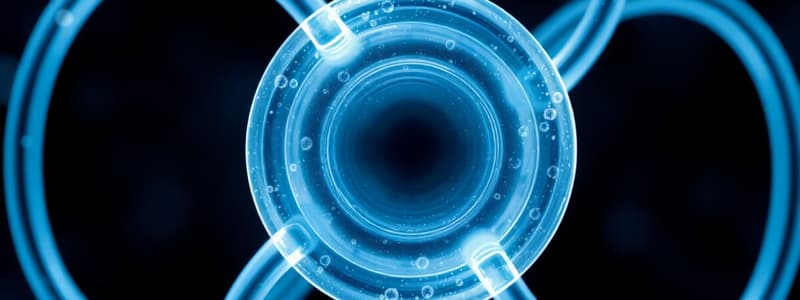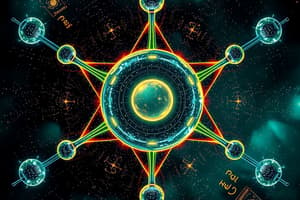Podcast
Questions and Answers
How many protons are in a carbon-12 atom?
How many protons are in a carbon-12 atom?
- 6 (correct)
- 8
- 4
- 10
Electrons have a significant mass compared to protons and neutrons.
Electrons have a significant mass compared to protons and neutrons.
False (B)
What is the atomic number of Sodium?
What is the atomic number of Sodium?
11
The atomic number of an element is determined by the number of __________.
The atomic number of an element is determined by the number of __________.
Match the following elements with their atomic numbers:
Match the following elements with their atomic numbers:
An atom of gold has more protons than neutrons.
An atom of gold has more protons than neutrons.
How many electrons are in an atom of gold?
How many electrons are in an atom of gold?
The number of neutrons in an atom of gold is equal to the mass number minus the atomic number, which is _________ (mass number) - 79 (atomic number).
The number of neutrons in an atom of gold is equal to the mass number minus the atomic number, which is _________ (mass number) - 79 (atomic number).
Match the following aspects of gold:
Match the following aspects of gold:
What is the radius of an atom approximately?
What is the radius of an atom approximately?
The nucleus of an atom contains electrons.
The nucleus of an atom contains electrons.
What particles are found in the nucleus of an atom?
What particles are found in the nucleus of an atom?
The relative mass of a neutron is ______ unit.
The relative mass of a neutron is ______ unit.
Match the following particles with their relative charge:
Match the following particles with their relative charge:
How does the mass of an electron compare to that of a proton?
How does the mass of an electron compare to that of a proton?
Almost all of an atom is solid matter.
Almost all of an atom is solid matter.
What is the approximate distance electrons would be from the nucleus if drawn to scale?
What is the approximate distance electrons would be from the nucleus if drawn to scale?
What happens to the mass number during alpha decay?
What happens to the mass number during alpha decay?
Beta decay results in the emission of a neutron from the nucleus.
Beta decay results in the emission of a neutron from the nucleus.
What particle is emitted during alpha decay?
What particle is emitted during alpha decay?
An alpha decay reaction can be represented by the equation AX → A − 4Y + 4______.
An alpha decay reaction can be represented by the equation AX → A − 4Y + 4______.
Match the type of decay with its description:
Match the type of decay with its description:
Which of the following types of radiation is the least penetrating?
Which of the following types of radiation is the least penetrating?
Gamma rays can be completely stopped by a thin sheet of lead.
Gamma rays can be completely stopped by a thin sheet of lead.
What material can stop alpha particles?
What material can stop alpha particles?
Beta particles are stopped by a few millimetres of __________.
Beta particles are stopped by a few millimetres of __________.
Match the type of radiation with its characteristics:
Match the type of radiation with its characteristics:
Which radiation type has a moderate ionising ability?
Which radiation type has a moderate ionising ability?
The range of gamma radiation in air is infinite.
The range of gamma radiation in air is infinite.
In a Geiger-Muller tube experiment, what are students trying to measure?
In a Geiger-Muller tube experiment, what are students trying to measure?
What causes some atomic nuclei to be unstable?
What causes some atomic nuclei to be unstable?
Carbon-14 is a stable isotope of carbon.
Carbon-14 is a stable isotope of carbon.
What is the main process that unstable nuclei go through to become more stable?
What is the main process that unstable nuclei go through to become more stable?
Unstable nuclei decay by emitting __________, which can be in the form of particles or waves.
Unstable nuclei decay by emitting __________, which can be in the form of particles or waves.
Match the types of radiation with their symbols:
Match the types of radiation with their symbols:
Which of the following correctly describes radiation?
Which of the following correctly describes radiation?
Scientists can accurately predict when a specific nucleus will decay.
Scientists can accurately predict when a specific nucleus will decay.
Name one type of radiation emitted during radioactive decay.
Name one type of radiation emitted during radioactive decay.
Flashcards
Atomic building block
Atomic building block
Atoms are the fundamental units of all matter.
Atomic radius
Atomic radius
Atoms are incredibly small, with a radius of 1 × 10−10 m.
Nucleus location
Nucleus location
A dense, central part of the atom containing protons and neutrons.
Nuclear size
Nuclear size
Signup and view all the flashcards
Proton (particle)
Proton (particle)
Signup and view all the flashcards
Neutron (particle)
Neutron (particle)
Signup and view all the flashcards
Electron (particle)
Electron (particle)
Signup and view all the flashcards
Electron mass
Electron mass
Signup and view all the flashcards
Atomic number
Atomic number
Signup and view all the flashcards
Protons
Protons
Signup and view all the flashcards
Electrons
Electrons
Signup and view all the flashcards
Carbon-12
Carbon-12
Signup and view all the flashcards
Number of electrons in Carbon-12
Number of electrons in Carbon-12
Signup and view all the flashcards
What is the atomic number?
What is the atomic number?
Signup and view all the flashcards
What is the mass number?
What is the mass number?
Signup and view all the flashcards
How to find neutrons?
How to find neutrons?
Signup and view all the flashcards
Isotopes
Isotopes
Signup and view all the flashcards
What determines the element?
What determines the element?
Signup and view all the flashcards
Alpha Decay
Alpha Decay
Signup and view all the flashcards
What does alpha decay produce?
What does alpha decay produce?
Signup and view all the flashcards
Why does alpha decay happen?
Why does alpha decay happen?
Signup and view all the flashcards
Beta Decay
Beta Decay
Signup and view all the flashcards
What causes beta decay?
What causes beta decay?
Signup and view all the flashcards
Radioactive decay
Radioactive decay
Signup and view all the flashcards
Alpha (α) particle
Alpha (α) particle
Signup and view all the flashcards
Beta (β-) particle
Beta (β-) particle
Signup and view all the flashcards
Gamma (γ) radiation
Gamma (γ) radiation
Signup and view all the flashcards
Why are some nuclei unstable?
Why are some nuclei unstable?
Signup and view all the flashcards
What happens during radioactive decay?
What happens during radioactive decay?
Signup and view all the flashcards
What is the significance of radiation?
What is the significance of radiation?
Signup and view all the flashcards
Is radioactive decay predictable?
Is radioactive decay predictable?
Signup and view all the flashcards
Alpha Radiation
Alpha Radiation
Signup and view all the flashcards
Beta Radiation
Beta Radiation
Signup and view all the flashcards
Gamma Radiation
Gamma Radiation
Signup and view all the flashcards
Penetrating Power
Penetrating Power
Signup and view all the flashcards
Ionizing Ability
Ionizing Ability
Signup and view all the flashcards
What is the least penetrating type of radiation?
What is the least penetrating type of radiation?
Signup and view all the flashcards
What material is needed to stop beta radiation?
What material is needed to stop beta radiation?
Signup and view all the flashcards
What material is effective in reducing gamma radiation?
What material is effective in reducing gamma radiation?
Signup and view all the flashcards
Study Notes
Atomic Structure
- Atoms are the building blocks of all matter
- Atoms have a tiny, dense nucleus at their centre, with electrons orbiting around the nucleus
- The radius of the nucleus is over 10,000 times smaller than the whole atom, but it contains almost all of the mass of the atom
- The radius of an atom is approximately 1 x 10⁻¹⁰ m
- The nucleus contains protons and neutrons
- Protons have a positive charge (+1) and a relative mass of 1
- Neutrons have no charge (0) and a relative mass of 1
- Electrons orbit the nucleus and have a negative charge (-1) and a relative mass of 1/2000 (negligible)
- The total charge within an atom is zero, because the number of electrons is equal to the number of protons
- Atoms of the same element will have the same number of protons.
Isotopes
- Isotopes are atoms of the same element with the same number of protons, but a different number of neutrons
- Each element can have more than one isotope
- Isotopes of the same element have equal numbers of protons but different numbers of neutrons
- Some isotopes are more unstable than others due to the imbalance of protons and neutrons
Types of Radiation
- Some atomic nuclei are unstable and radioactive
- This is because of an imbalance of protons or neutrons in the nucleus
- Unstable nuclei decay by emitting high energy particles or waves
- The different types of radiation that can be emitted are:
- Alpha (α) particles: consist of 2 protons and 2 neutrons; low penetrating power
- Beta (β) particles: high-energy electrons; moderate penetrating power
- Gamma (γ) radiation: electromagnetic waves; high penetrating power
- Alpha particles are also helium nuclei
- Beta particles are high energy electrons
- Gamma rays are electromagnetic waves
- The radiation emitted in radioactive decay removes energy from the nucleus, making it more stable.
Decay Equations
- Alpha decay: The mass number of the nucleus decreases by 4, and the atomic number decreases by 2
- Beta decay: The mass number of the nucleus stays the same, and the atomic number increases by 1
- Gamma decay: The mass number and atomic number of the nucleus remain the same, only energy is reduced
- Neutron emission: The mass number of the nucleus is reduced by one while the atomic number remains the same
Detecting Radiation
- Photographic film: darkens when exposed to ionizing radiation. The exposure can be measured by the darkness of the film.
- Geiger-Müller tube: detects ionizing radiation by measuring the electrical pulses produced by the radiation. The more frequent the pulses, the higher the radiation level
- Background radiation: natural radiation present in the environment; must be accounted for in measuring radiation from sources
Studying That Suits You
Use AI to generate personalized quizzes and flashcards to suit your learning preferences.




